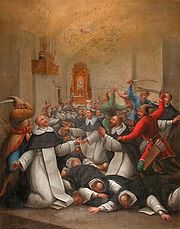| Second Mongol invasion of Poland | |||||||
|---|---|---|---|---|---|---|---|
| Part of the Mongol invasion of Europe | |||||||
 Martyrdom of Sadok and 48 dominican martyrs of Sandomierz during the Second Mongol invasion of Poland. | |||||||
| |||||||
| Belligerents | |||||||
| File:White Sulde of the Mongol Empire.jpg Mongol Empire |
| ||||||
| Commanders and leaders | |||||||
|
File:White Sulde of the Mongol Empire.jpg Berke File:White Sulde of the Mongol Empire.jpg Burundai |
various others | ||||||
| Strength | |||||||
| about 30,000 (three tumens) | unknown | ||||||
| Casualties and losses | |||||||
| Light | Heavy | ||||||
| |||||
The second Mongol invasion of Poland was carried out by general Boroldai (Burundai) in 1259-1260. During this invasion the cities of Sandomierz, Krakow, Lublin, Zawichost, and Bytom were sacked by Mongols for the second time.[1]
The invasion began in late 1259, after a powerful Mongol army had been sent to the Kingdom of Galicia–Volhynia in order to punish King Daniel of Galicia for his independent actions. King Daniel had to comply to Mongol demands, and in 1258, his forces joined the Mongols in the raid on the Grand Duchy of Lithuania. To weaken Daniel’s position, the Golden Horde decided to attack his allies, Hungarian King Bela IV, and Duke of Krakow, Boleslaw V the Chaste.
The purpose of the invasion was to loot the divided Kingdom of Poland (see Testament of Boleslaw III Krzywousty), and to weaken Duke of Krakow Boleslaw V the Chaste, whose province, Lesser Poland, began a process of fast development. According to the Mongol plan, the invaders were to enter Lesser Poland east of Lublin, and head towards Zawichost. After crossing the Vistula, the Mongol army was to break into two columns, operating north and south of the Holy Cross Mountains. The columns were to unite near Checiny, and then head southwards, to Krakow. Altogether, Mongol forces under Boroldai were 30,000 strong, with Ruthenian units of King Daniel, Kipchaks and probably Lithuanians or Yotvingians.
The events that took place in the Kingdom of Galicia–Volhynia echoed in Lesser Poland, and in late 1258, preparations for the defence of Krakow began. The work was quickly abandoned, and Piast dynasty dukes returned to their internal quarrels. In October 1259, right before the invasion, Duke of Greater Poland Boleslaw the Pious allied himself with Duke Boleslaw V the Chaste and Duke of Mazovia Siemowit I, in order to attack Duke of Kujawy, Casimir I of Kuyavia. A few weeks later, Lesser Poland was invaded by the Asiatic hordes.
Mongolian army concentrated near Chelm, and after capturing Polish towns east of the Vistula, the invaders appeared at Sandomierz (early December 1259). Boroldai ordered Ruthenian auxiliary units to besiege and capture the city, while main Mongol forces marched westwards, to the Holy Cross Mountains. Their march was marked by an orgy of destruction; among others, ancient abbeys of Koprzywnica and Wachock were looted (most probably, they failed to capture the Lysa Gora Benedictine Abbey). The Mongols limited their advance to Radom in the north and Sulejow in the west, and did not enter other Polish provinces. The two columns of the invading army joined forces near Kielce and Checiny, in mid-January 1260.
At the same time, the siege of Sandomierz continued. Defenders of the city fiercely resisted all attacks of the Mongol and Ruthenian forces. After several weeks, Mongol leaders began negotiations with the Poles, who were commanded by a man named Piotr of Krepa. Ruthenian princes, which took part in the siege, advised Piotr of Krepa to accept Mongol offer, and abandon Sandomierz, in exchange of safe passage for all residents of the city. Finally, facing hunger and epidemics, Poles and left Sandomierz on February 2, 1260. The Mongols, as predicted, broke their promises, and massacred the civilians and the defenders. The city itself was looted and burned to the ground.
On February 5, main Mongol forces abandoned Sandomierz. All units joined forces on February 10–12, and entered densely populated southern Lesser Poland. After looting the abbeys at Jedrzejow, Mogila, Szczyrzyc and Miechow, the invaders flooded the region, in an orgy of murder and destruction. In the second half of February, the Mongols reached Krakow, quickly capturing the city, but without the Wawel Hill, which was fortified and defended. To prevent Silesian Piast dukes from sending their support to Lesser Poland, Boroldai sent some units to the area of Bytom. Duke Boleslaw V the Chaste himself fled to Sieradz, with his wife Kinga of Poland.
In late March 1260, the Mongols left Lesser Poland, along the Carpathian foothills. The province that they had invaded was completely destroyed, with rich looty some 10,000 Poles taken with the invaders as slaves. The success of the Golden Horde was complete, as they managed to destroy an anti-Mongol alliance, and completely subjugate Kingdom of Galicia–Volhynia.
References[]
- ↑ Stanisław Krakowski, Polska w walce z najazdami tatarskimi w XIII wieku, MON, 1956, pp. 181-201
The original article can be found at Second Mongol invasion of Poland and the edit history here.